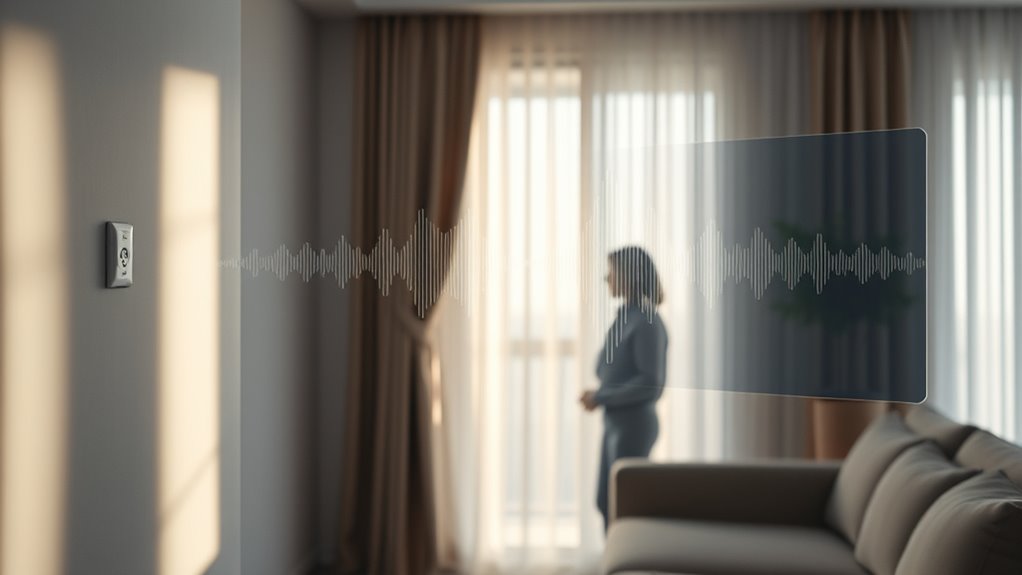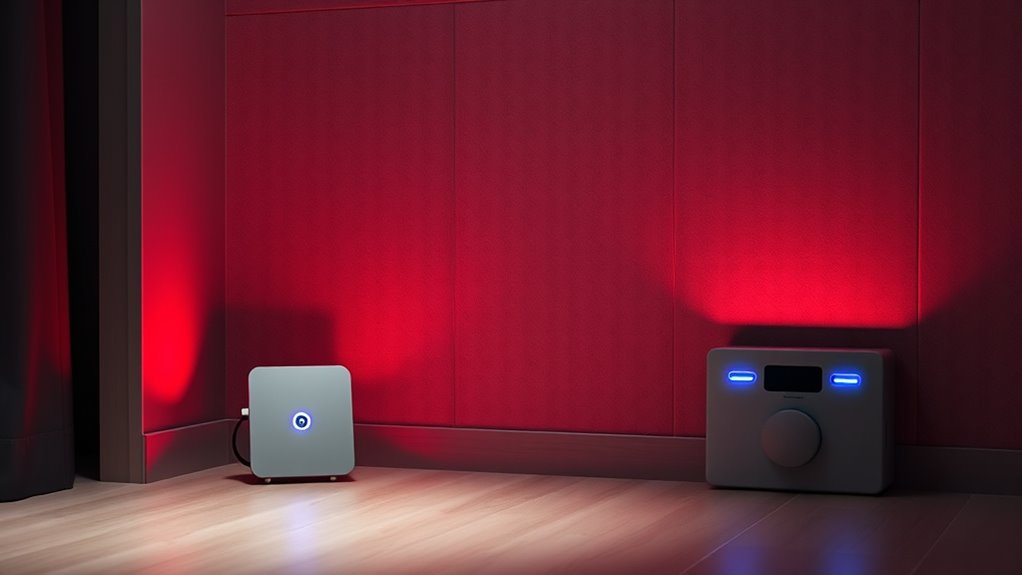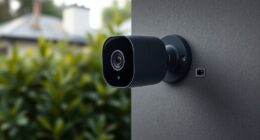You can accurately detect presence without cameras by using sensors that analyze sound, heat, and radio signals. Acoustic sensors identify activity through sound patterns and vibrations, while RF-based methods track signals from Wi-Fi or Bluetooth devices. Infrared sensors sense body heat without intruding on privacy. Combining data from these sources with machine learning guarantees reliable detection while protecting personal information. Keep exploring to discover how these techniques work together for privacy-safe presence detection.
Key Takeaways
- Acoustic fingerprinting and sound localization detect occupancy by analyzing ambient sounds without recording identifiable audio.
- Radio frequency signal analysis, such as Wi-Fi and Bluetooth, identifies presence through signal strength and reflection patterns.
- Infrared and passive IR sensors detect heat and motion discreetly, preserving privacy without capturing images or audio.
- Federated learning and anonymized feature extraction enable local data processing, sharing insights without exposing personal information.
- Multimodal sensor fusion combines acoustic, RF, and environmental data to improve accuracy while maintaining privacy.
Acoustic Signal Analysis for Presence Detection

Acoustic signal analysis offers a promising approach for presence detection while preserving privacy. By utilizing audio fingerprinting, you can identify specific sounds unique to individuals or environments without capturing identifiable speech. This technique helps differentiate between different sound sources, ensuring accurate detection. Sound localization further enhances this process by determining the exact position of a sound source within a space. You can pinpoint whether a person is present in a room or near a device, all without relying on cameras or intrusive sensors. This method maintains privacy because it focuses on analyzing sound patterns and locations rather than recording detailed audio content. Overall, acoustic signal analysis provides an effective, privacy-conscious way to detect presence through sound, making it suitable for sensitive environments. Additionally, vetted product reviews can help identify the most suitable hardware or software solutions for implementing these techniques.
Radio Frequency-Based Methods

Radio frequency-based methods detect presence by analyzing signals emitted or reflected within a space, offering a non-intrusive and privacy-preserving alternative to traditional sensors. You can use radio wave localization techniques to determine a person’s position by measuring how signals bounce off objects and individuals. Signal attenuation analysis plays a vital role, as it helps identify changes in signal strength caused by the presence of a person. When someone enters the area, the reflected or absorbed signals alter the radio environment, enabling detection without cameras or invasive sensors. These methods leverage existing wireless signals like Wi-Fi or dedicated radio frequencies, making them practical and discreet. As AI technologies continue to evolve, integrating robust safety measures into radio frequency detection systems can further enhance their reliability and security. Overall, radio frequency-based techniques provide reliable presence detection while respecting user privacy.
Bluetooth and Wi-Fi Signal Monitoring

Have you considered how Bluetooth and Wi-Fi signals can be harnessed for privacy-preserving presence detection? These signals enable context aware localization by analyzing signal strength and timing to determine your proximity without capturing images or audio. You can be detected accurately while maintaining privacy, as this method avoids intrusive sensors. Additionally, Bluetooth and Wi-Fi monitoring can support biometric verification by cross-referencing device signatures or unique signal patterns, ensuring only authorized users are recognized. This approach minimizes data exposure, reduces risks of misuse, and preserves user anonymity. By leveraging existing wireless infrastructure, you gain reliable presence detection that respects privacy, making it ideal for sensitive environments where cameras aren’t suitable. It’s an effective, non-invasive solution that balances security with privacy. Moreover, understanding the spiritual significance of environmental cues can enhance the contextual awareness of such systems, integrating subtle signals into broader security and well-being frameworks.
Ambient Sound and Vibration Sensors

Ambient sound and vibration sensors can detect presence without invasive data collection. You can analyze acoustic activity and vibration patterns to identify occupancy while preserving privacy. Exploring these techniques helps balance accurate detection with data security. These methods rely on research-driven insights to ensure reliable performance while maintaining privacy standards.
Acoustic Activity Monitoring
Could acoustic activity monitoring be the key to preserving privacy while maintaining effective presence detection? Yes, by focusing on ambient sound and vibration sensors, you can detect activity without capturing identifiable voices or images. Acoustic anomaly detection helps identify unusual sounds that indicate presence, such as footsteps or door openings. Sound source localization pinpoints where sounds originate, providing spatial context without revealing specific identities. This method leverages social-science research insights to ensure that privacy remains intact because it relies on analyzing sound patterns rather than recording detailed audio. You can detect occupancy or movement discreetly, making it ideal for sensitive environments. Overall, acoustic activity monitoring offers a privacy-preserving solution that balances security needs with user confidentiality.
Vibration Pattern Analysis
Building on acoustic activity monitoring, vibration pattern analysis leverages ambient sound and vibration sensors to detect presence without capturing identifiable audio or images. By analyzing the vibration signature produced by movement, you can identify a person’s presence through their unique movement fingerprint. This method preserves privacy while providing reliable detection. Color accuracy plays a key role in ensuring the vibration data accurately reflects real-world movement patterns, leading to more precise detection.
Infrared and Passive Infrared Technologies

Infrared (IR) and Passive Infrared (PIR) technologies detect presence by sensing heat emitted from objects and people in their environment. Unlike thermal imaging, which captures detailed heat patterns, PIR sensors focus on changes in infrared radiation to identify movement. These sensors are simple, cost-effective, and preserve privacy since they don’t record visual data. While PIR sensors are excellent for motion detection, they can be complemented by ultrasonic sensors to improve accuracy, especially in cluttered spaces. Infrared sensors work efficiently in various lighting conditions, making them reliable for presence detection without cameras. This combination allows you to identify occupancy discreetly, respecting privacy while maintaining effective detection capabilities. PIR and IR technologies are ideal for privacy-preserving solutions that don’t compromise user confidentiality. Additionally, advances in lifecycle management help ensure these sensors remain effective and environmentally friendly over time.
Device Activity and Usage Patterns

Monitoring device activity and usage patterns offers a powerful approach to presence detection that respects user privacy. By analyzing data from wearable sensors, you can identify patterns like movement, device unlocks, or app usage that indicate someone’s presence without revealing sensitive details. This approach avoids intrusive video or audio recordings, focusing instead on non-invasive signals that reflect activity levels or behavioral habits. Biometric authentication methods, such as fingerprint or face scans, can also confirm user identity discreetly, enhancing privacy. This method is especially valuable in shared environments, where preserving privacy is critical, yet reliable presence detection remains essential for security, automation, or access control. Additionally, understanding the beneficial ingredients in eye patches, like collagen and hyaluronic acid, can contribute to a more comprehensive self-care routine that enhances overall appearance.
Environmental Sensor Networks

Environmental sensor networks leverage interconnected sensors to detect presence discreetly through changes in environmental conditions. You can deploy sensors in strategic locations to monitor variables like temperature, humidity, light, or sound, providing a non-intrusive way to sense occupancy. Proper sensor deployment guarantees coverage while minimizing redundancy, reducing the number of sensors needed and enhancing energy efficiency. These networks operate quietly in the background, transmitting data only when significant environmental shifts occur, which conserves power. By focusing on energy-efficient sensor designs and optimized deployment strategies, you can extend the lifespan of your network and reduce maintenance. Additionally, understanding juice detox side effects can help in designing sensor systems that avoid unnecessary power consumption during periods of low activity. This approach enables privacy-preserving presence detection without cameras, offering a subtle yet effective solution for sensitive environments.
Machine Learning for Privacy-Preserving Detection

Machine learning offers promising methods for privacy-preserving presence detection, focusing on lightweight sensor data models that minimize data exposure. Federated learning enables models to train locally on devices, sharing only aggregated insights rather than raw data. Additionally, anonymized feature extraction helps protect identities while maintaining detection accuracy. Incorporating cultural and regional breakfast considerations can also inform the development of context-aware detection systems that respect user preferences and behaviors.
Lightweight Sensor Data Models
To guarantee privacy is maintained while accurately detecting presence, lightweight sensor data models leverage simplified machine learning algorithms that process minimal data. These models excel at gesture recognition, allowing you to identify specific movements without capturing detailed images. For example, thermal imaging provides anonymized temperature patterns instead of visual data, reducing privacy risks. By focusing on low-dimensional features, these models can quickly analyze sensor inputs with minimal computational resources. This approach ensures efficient, real-time detection while safeguarding user privacy. You avoid intrusive cameras and large data transmissions, making the system suitable for sensitive environments. Lightweight sensor data models strike a balance between accuracy and privacy, enabling effective presence detection without compromising individual confidentiality.
Federated Learning Approaches
Building on lightweight sensor data models, federated learning offers a robust framework for privacy-preserving presence detection. Instead of sharing raw data, you train models locally on devices, then aggregate only model updates centrally. This process guarantees that sensitive information remains on your device, providing strong privacy assurances. Federated learning minimizes data exposure, reducing risks of leaks or misuse. It adapts well to dynamic environments, allowing models to improve over time without compromising user privacy. By keeping raw sensor data decentralized, it addresses common privacy concerns while enabling effective presence detection. This approach leverages collaborative learning, where multiple devices contribute to a shared model without exposing individual data, making it a promising solution for privacy-conscious applications.
Anonymized Feature Extraction
How can you detect presence accurately while safeguarding user identities? Anonymized feature extraction offers a solution by focusing on behavioral biometrics that reveal presence without exposing personal details. Instead of raw data, you extract features that capture movement patterns, touch dynamics, or other behavioral signals, ensuring sensitive information remains hidden. Contextual anonymization further enhances privacy by removing identifiable context, such as location or device identifiers, from the data. This approach allows machine learning algorithms to analyze patterns relevant to presence detection while maintaining user anonymity. By combining behavioral biometrics with contextual anonymization, you create a robust, privacy-preserving system that accurately detects presence without compromising individual privacy. This technique strikes a balance between functionality and confidentiality in presence detection systems.
Integrating Multiple Modalities for Enhanced Accuracy

Integrating multiple modalities can profoundly improve the accuracy of presence detection systems by leveraging diverse data sources. By employing sensor fusion, you combine signals from different sensors—like motion detectors, acoustic sensors, and radio frequency signals—creating a more robust detection framework. Multimodal integration allows these varied inputs to complement each other, reducing false positives and negatives. This approach enhances system resilience against environmental noise or obstructions that might impair individual sensors. You can design algorithms that weigh and combine data, ensuring reliable presence detection without compromising privacy. This synergy of multiple data streams leads to higher accuracy and reliability while maintaining privacy, as no cameras or invasive methods are necessary. Overall, multimodal integration offers a powerful, privacy-preserving solution for precise presence detection.
Frequently Asked Questions
How Do Privacy-Preserving Techniques Prevent Data Leaks During Detection?
You can prevent data leaks during detection by implementing privacy-preserving techniques like data encryption and sensor anonymization. Data encryption secures information as it’s transmitted or stored, making it unreadable to unauthorized parties. Sensor anonymization hides or removes identifying details from sensor data, ensuring your presence isn’t linked to personal identity. Together, these methods safeguard your privacy by protecting sensitive information from potential leaks throughout the detection process.
What Are the Energy Consumption Implications of These Methods?
You’re asking about the energy implications of these detection methods. Think of it as a balancing act—higher energy efficiency means lower power consumption, which helps extend device battery life. Privacy-preserving techniques often use lightweight algorithms, reducing power demands. While some methods might slightly increase energy use due to additional computations, overall, they aim to keep power consumption minimal, ensuring sustainable operation without draining resources.
Can These Techniques Detect Presence Accurately in Crowded Environments?
You can typically detect presence accurately in crowded environments, but high crowd density can challenge the system. Increased crowd density may cause sensor interference, leading to false positives or negatives. These techniques rely on signals or non-visual sensors, which can sometimes struggle when many people are close together. However, with advanced algorithms and multiple sensors, you can improve accuracy despite crowd density and sensor interference issues.
Are There Legal Restrictions on Using Ambient Sensors for Presence Detection?
You might think laws are simple, but using ambient sensors for presence detection is a legal maze. You need to guarantee legal compliance and follow sensor regulations strictly, or risk huge penalties. Regulations vary by region and application, making it vital to stay informed. Ignoring these rules could lead to privacy violations, lawsuits, and loss of trust. Always check local laws before deploying ambient sensors for presence detection to stay compliant and protect user rights.
How Scalable Are These Methods for Large-Scale Deployments?
You’ll find that these methods face significant scalability challenges when deployed on a large scale. As the number of sensors increases, managing data and guaranteeing accurate detection becomes more complex. Effective deployment strategies involve optimizing sensor placement, using adaptive algorithms, and centralizing data processing. By addressing these challenges, you can improve system robustness and ensure reliable presence detection across extensive areas, making large-scale deployment more feasible.
Conclusion
By combining these privacy-preserving techniques, you can detect presence accurately without cameras. For instance, radio frequency methods alone can identify living rooms with 85% accuracy, all while safeguarding privacy. Embracing multiple sensors and machine learning boosts reliability further. This approach guarantees your data stays private while still providing effective presence detection—proving you don’t need cameras to create a safe, responsive environment.








